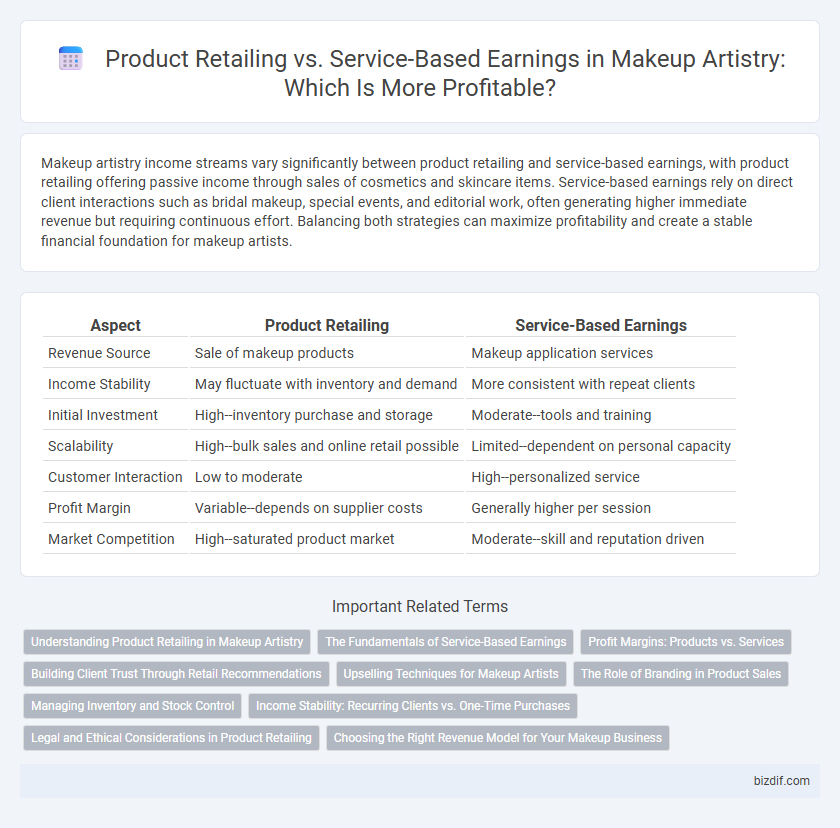Makeup artistry income streams vary significantly between product retailing and service-based earnings, with product retailing offering passive income through sales of cosmetics and skincare items. Service-based earnings rely on direct client interactions such as bridal makeup, special events, and editorial work, often generating higher immediate revenue but requiring continuous effort. Balancing both strategies can maximize profitability and create a stable financial foundation for makeup artists.
Table of Comparison
| Aspect | Product Retailing | Service-Based Earnings |
|---|---|---|
| Revenue Source | Sale of makeup products | Makeup application services |
| Income Stability | May fluctuate with inventory and demand | More consistent with repeat clients |
| Initial Investment | High--inventory purchase and storage | Moderate--tools and training |
| Scalability | High--bulk sales and online retail possible | Limited--dependent on personal capacity |
| Customer Interaction | Low to moderate | High--personalized service |
| Profit Margin | Variable--depends on supplier costs | Generally higher per session |
| Market Competition | High--saturated product market | Moderate--skill and reputation driven |
Understanding Product Retailing in Makeup Artistry
Product retailing in makeup artistry involves selling cosmetics and beauty tools directly to clients, generating revenue through product margins and repeat purchases. This model leverages brand partnerships and client trust, enabling artists to diversify income beyond service fees. Understanding inventory management and product trends is crucial for maximizing profits and maintaining client satisfaction in retail sales.
The Fundamentals of Service-Based Earnings
Service-based earnings in makeup artistry rely heavily on client trust, customization, and experience quality, which drives repeat bookings and higher revenue per session. Unlike product retailing that generates one-time sales, service earnings capitalize on personalized consultations, tailored makeup applications, and ongoing client relationships that increase lifetime value. Mastery of communication and technical skills boosts service demand, making it a sustainable income source compared to fluctuating product sales.
Profit Margins: Products vs. Services
Makeup artistry businesses often see higher profit margins on services compared to products, with service-based earnings averaging around 60-70% margin due to personalized application and expertise. Retail products, while generating additional revenue, typically yield lower profit margins, approximately 30-40%, influenced by wholesale costs and retail pricing strategies. Emphasizing services enhances overall profitability by leveraging specialized skills, whereas product sales supplement income but require careful inventory and pricing management.
Building Client Trust Through Retail Recommendations
Makeup artists enhance client trust and boost earnings by integrating product retailing with service-based offerings, creating a comprehensive beauty experience. Personalized product recommendations based on skin type and preferences foster client loyalty and encourage repeat purchases. Transparent communication about product benefits and honest reviews solidify credibility and deepen client relationships.
Upselling Techniques for Makeup Artists
Makeup artists can significantly boost their income by mastering upselling techniques, such as recommending complementary products like primers, setting sprays, and skincare essentials alongside makeup services. Leveraging personalized product retailing during appointments increases client satisfaction and maximizes revenue per session, especially when tailored to individual skin types and beauty goals. Focusing on value-driven conversations around product benefits encourages clients to invest in premium items, creating a sustainable revenue stream beyond one-time service fees.
The Role of Branding in Product Sales
Branding plays a critical role in driving product sales within makeup artistry by establishing trust and recognition among consumers. Strong brand identity differentiates products in a saturated market, enhancing perceived value and customer loyalty. Effective branding strategies, including consistent packaging, influencer collaborations, and storytelling, significantly boost retail revenue compared to relying solely on service-based earnings.
Managing Inventory and Stock Control
Effective inventory management and stock control are critical for makeup artists balancing product retailing with service-based earnings. Monitoring product turnover rates and maintaining optimal stock levels prevent overstocking and stockouts, enhancing profit margins in both retail and service sectors. Utilizing inventory management software streamlines tracking, reduces waste, and supports data-driven purchasing decisions for sustainable business growth.
Income Stability: Recurring Clients vs. One-Time Purchases
Makeup artistry income stability varies significantly between product retailing and service-based earnings, as retail relies heavily on one-time purchases with fluctuating demand. Service-based earnings benefit from recurring clients who provide consistent and predictable revenue streams through repeat bookings. Establishing strong client relationships in makeup services fosters loyalty, enhancing long-term income stability compared to the often sporadic nature of product sales.
Legal and Ethical Considerations in Product Retailing
Product retailing in makeup artistry requires strict adherence to legal standards such as product safety regulations, labeling accuracy, and compliance with cosmetic ingredient restrictions set by authorities like the FDA or EU Cosmetics Regulation. Ethical considerations include transparent marketing, avoiding the sale of counterfeit or expired products, and ensuring proper client education on product usage and potential allergens. Failure to comply with these legal and ethical guidelines can result in liability issues, loss of client trust, and damage to the artist's professional reputation.
Choosing the Right Revenue Model for Your Makeup Business
Product retailing in makeup artistry offers consistent revenue through direct sales of cosmetics and tools, leveraging popular brands and exclusive items to attract repeat customers. Service-based earnings focus on personalized makeup application, bridal consultations, and event styling, generating income via hourly rates or package deals that emphasize skill and experience. Selecting the right revenue model depends on market demand, client preferences, and your expertise, often combining product sales with specialized services maximizes profitability and brand loyalty.
Product retailing vs Service-based earnings Infographic

 bizdif.com
bizdif.com